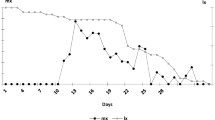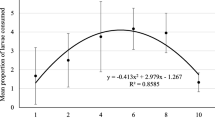Abstract
The life history ofNephus reunioni, introduced from the Reunioni island has been studied. Optimum temperature for the development of the entomophagous insect is 24–25°C. In this case the population has the highest survival at preimaginal stages, life duration of adults and reproductive capacity. The rate of population growth was calculated by the formula:
, were R0-reproduction coefficient, T-generation development time. W shows the daily increase in the predator population and is maximum at 29°C.N. reunioni is capable of successfully developing within the wide range of relative humidity. Relative humidity of 55±5% is optimum for development of the population. Due to its ecological plasticityN. reunioni can be used in biological control of mealybugs on a much greater area than the earlier introducedCryptolaemus montrouzieri (Mulsant).
Résumé
La biologie deNephus reunioni introduit de l'Ile de la Réunion a été étudiée. La température optimale pour le développement de l'insecte entomophage est 24–25°C. Dans ce cas la survie des stades préimaginaux est la plus forte, comme la durée de vie des adultes et la capacité de reproduction. Le taux de croissance de la population était calculé au moyen de la formule suivante:
où R0 est le coefficient de reproduction et T la durée de développement d'une génération. W représente la croissance quotidienne de la population prédatrice elle est maximum à 29°C.N. reunioni est capable de se développer dans une très large échelle d'humidité relative. Celle de 55±5% est optimale pour le développement de la population. Du fait de sa plasticité écologique,N. reunioni peut être employé dans la lutte biologique menée contre les Pseudococcines sur une aire beaucoup plus vaste qu'avecCryptolaemus montrouzieri, introduit primitivement.
Similar content being viewed by others
References
Chazeau J., Etienne J. &Fürsch H. — 1974. Les Coccinellidae de l'Ile de la Réunion [Insecta, Coleoptera]. —Bull. Mus. Nat. Hist. Natur. Zool., 3 sér., N° 210, 140, 265–267.
Fisher T. W. — 1963. Mass culture ofCryptolaemus andLeptomastix, natural enemies of citrus mealybugs. —Calif. Agr. Expt. Sta. Bull., N° 797, 1–38.
Pianka E. R. — 1978. Evolutionary ecology. (2nd ed.) —Harper & Row, New York, Hagerstown, San-Francisco, London.
Smetnik A. I. & Izhevsky S. S. — 1979. The introduction and practical application of beneficial organisms for pest control in the USSR. — In: Proceedings of the Joint American-Soviet Conference on Use of Beneficial Organisms in the Control of Crop Pests. Wash., 33–35.
Williamson M. — 1972. The Analysis of Biological Populations. —Edward Arnold, University of York, London.
Author information
Authors and Affiliations
Rights and permissions
About this article
Cite this article
Izhevsky, S.S., Orlinsky, A.D. Life history of the importedScymnus (Nephus) Reunioni [Col.: Coccinellidae] predator of mealybugs. Entomophaga 33, 101–114 (1988). https://doi.org/10.1007/BF02372318
Received:
Accepted:
Issue Date:
DOI: https://doi.org/10.1007/BF02372318




